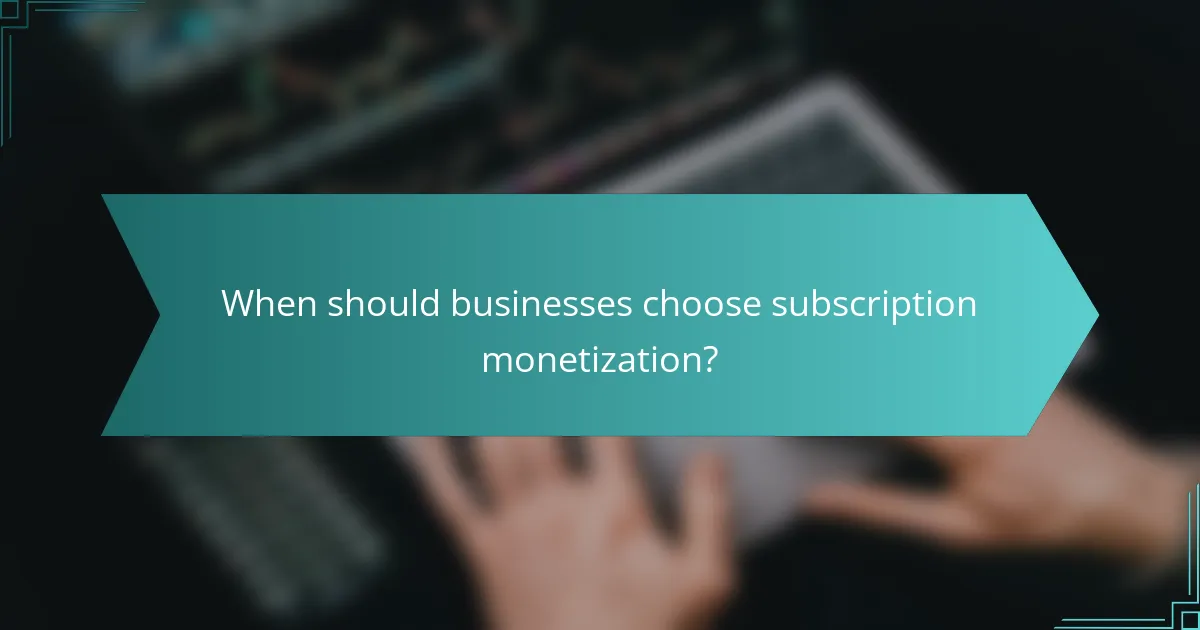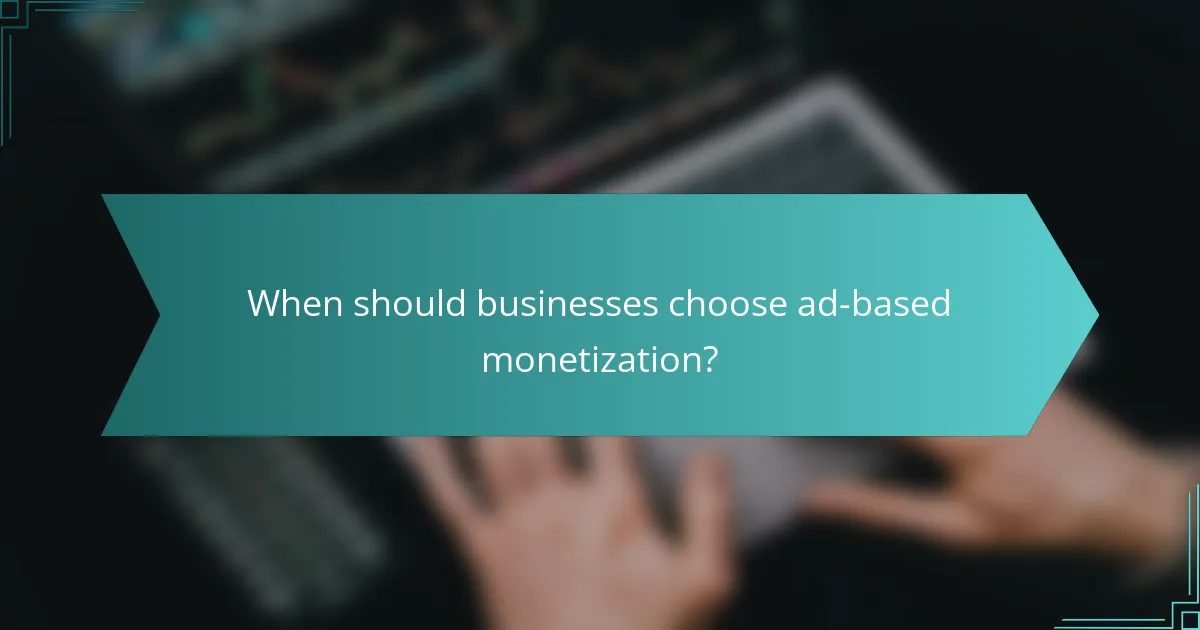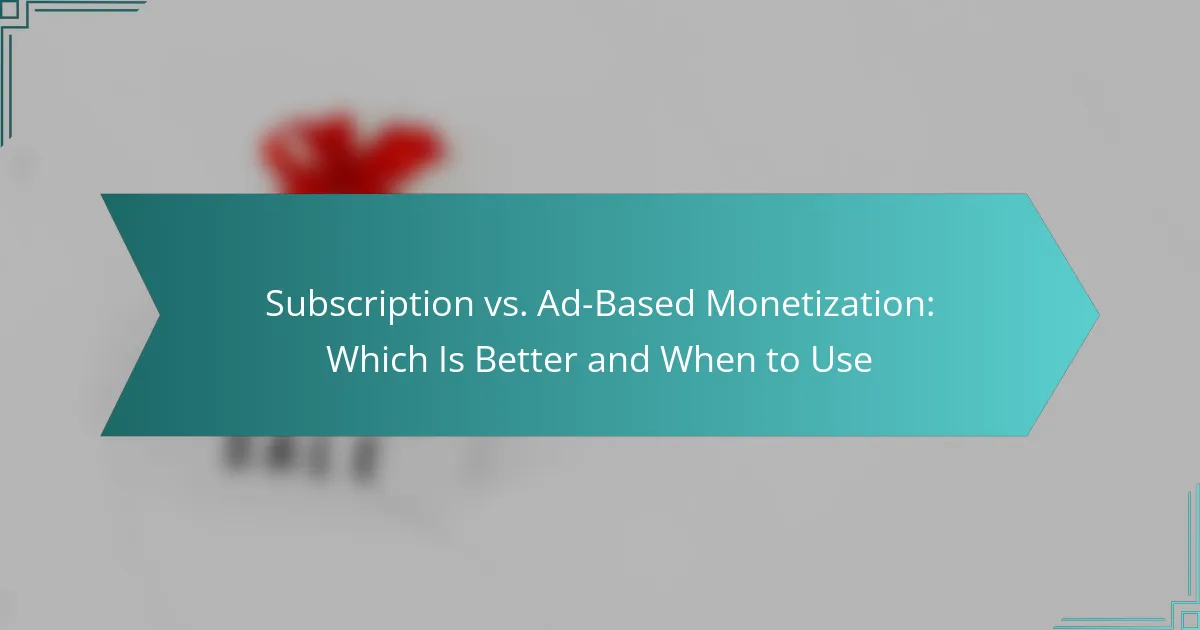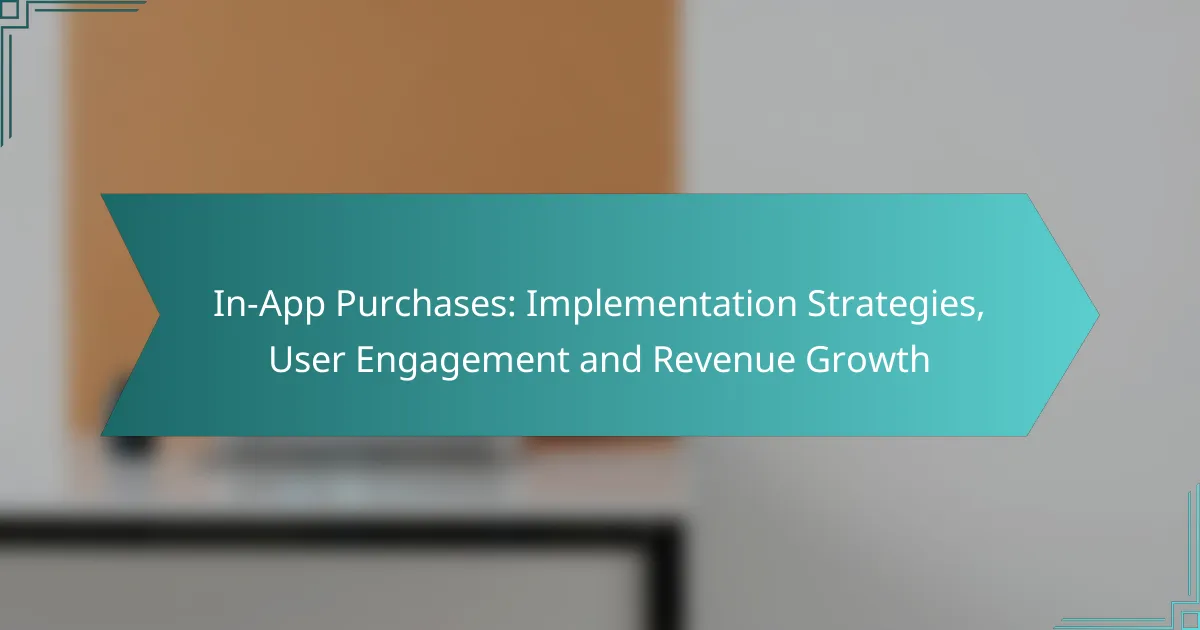When deciding between subscription and ad-based monetization, businesses must weigh the benefits of each model in relation to their goals and audience. Subscription monetization offers stable income and fosters strong customer relationships, making it ideal for services with regular engagement. In contrast, ad-based monetization allows for free access to content while generating revenue through advertisements, appealing to a broader audience. Understanding when to use each approach is crucial for maximizing profitability and customer satisfaction.

What are the advantages of subscription monetization in Canada?
Subscription monetization in Canada offers several key benefits, including stable income and stronger customer relationships. This model allows businesses to predict revenue more accurately and foster loyalty among subscribers, making it an attractive option for many companies.
Predictable revenue streams
One of the primary advantages of subscription monetization is the predictable revenue it generates. Businesses can forecast their income based on the number of active subscribers, which helps in budgeting and planning. For example, a service charging CAD 10 per month with 1,000 subscribers can expect a monthly revenue of CAD 10,000.
This predictability allows companies to invest in growth initiatives and improve their offerings without the uncertainty that often accompanies ad-based models, where revenue can fluctuate significantly based on market conditions.
Enhanced customer loyalty
Subscription models tend to create stronger customer loyalty compared to ad-based monetization. Subscribers often feel a sense of commitment to a service they pay for regularly, leading to longer retention rates. This loyalty can translate into higher customer lifetime value, as satisfied subscribers are more likely to renew their subscriptions.
To enhance loyalty, businesses can offer exclusive content or perks to subscribers, reinforcing their decision to remain engaged with the service.
Access to user data for personalization
With subscription monetization, companies gain valuable insights into user behavior and preferences. This data can be leveraged to personalize offerings, improving user experience and satisfaction. For instance, a streaming service can analyze viewing habits to recommend content tailored to individual subscribers.
Personalization not only enhances user engagement but also increases the likelihood of renewals, as customers feel that the service is tailored to their needs.
Lower churn rates
Subscription models typically experience lower churn rates compared to ad-based models. This is largely due to the established relationship between the service and its subscribers. When customers feel they are receiving value for their money, they are less likely to cancel their subscriptions.
To further reduce churn, businesses should focus on delivering consistent quality and addressing customer feedback promptly. Regular communication and updates can also help maintain subscriber interest and satisfaction.

What are the advantages of ad-based monetization in Canada?
Ad-based monetization in Canada offers several benefits, particularly for content creators looking to maximize their audience and revenue without charging users directly. This approach allows businesses to generate income through advertisements while providing free access to their content.
Wider audience reach
Ad-based monetization typically attracts a larger audience since users can access content without any financial commitment. This model appeals to cost-sensitive consumers who may be reluctant to pay for subscriptions, thereby increasing traffic and engagement.
For example, platforms like YouTube and many news websites thrive on ad revenue by offering free content, which helps them reach millions of users. The broader audience can lead to more advertising opportunities and partnerships.
No upfront cost for users
One of the key advantages of ad-based monetization is that it imposes no upfront costs on users. This accessibility encourages more people to engage with the content, as they can enjoy it without worrying about subscription fees.
This model is particularly effective in Canada, where consumers may prefer free options over paid subscriptions. By removing financial barriers, content creators can build a loyal user base that may be more likely to convert to paid options in the future.
Potential for higher short-term revenue
Ad-based monetization can generate higher short-term revenue compared to subscription models, especially if the content attracts significant traffic. Advertisers often pay based on impressions or clicks, which can lead to substantial earnings during peak engagement periods.
For instance, a popular blog or video channel can earn hundreds to thousands of Canadian dollars monthly from ad placements, depending on their audience size and engagement rates. This immediate revenue can be crucial for startups or creators looking to fund their projects quickly.

When should businesses choose subscription monetization?
Businesses should consider subscription monetization when they aim to create a steady revenue stream and foster ongoing relationships with their customers. This model is particularly effective for services or content that users engage with regularly and are willing to pay for consistently.
Content with high user engagement
Subscription monetization works best for content that keeps users actively engaged, such as streaming services, online courses, or premium news platforms. If your content encourages frequent visits and prolonged interaction, users are more likely to see value in a subscription.
Examples include platforms like Netflix or Spotify, where users consume content regularly. Businesses should assess user engagement metrics to determine if a subscription model aligns with their content consumption patterns.
Long-term customer relationships
Choosing a subscription model is ideal for businesses that prioritize building long-term relationships with their customers. This approach fosters loyalty, as subscribers often feel more connected to a brand when they invest in it over time.
Companies can enhance these relationships by offering personalized experiences or rewards for long-term subscribers. Regular communication and updates can also strengthen customer ties and reduce churn rates.
Exclusive content offerings
Subscription monetization is particularly effective when businesses can provide exclusive content that is not available elsewhere. This could include specialized articles, unique video content, or early access to new features.
By offering exclusive content, businesses can justify the subscription fee and attract users who are willing to pay for access to premium materials. Consider creating tiered subscription levels to cater to different customer preferences and budgets, enhancing the perceived value of the offerings.

When should businesses choose ad-based monetization?
Businesses should consider ad-based monetization when they have substantial web traffic and want to offer free content to users. This model allows for revenue generation through advertisements while keeping access open, making it appealing for various content types.
High traffic websites
Ad-based monetization is particularly effective for high traffic websites, as more visitors lead to greater ad impressions and potential revenue. Websites with thousands to millions of monthly visitors can leverage this model to maximize earnings without charging users directly.
To optimize ad revenue, focus on user engagement and retention strategies that keep visitors returning. Utilizing analytics tools can help identify peak traffic times and popular content, allowing for strategic ad placements.
Free-to-access content models
For businesses that prioritize accessibility, ad-based monetization works well with free-to-access content models. This approach attracts a larger audience who may be deterred by subscription fees, thus increasing overall traffic and ad revenue potential.
Consider implementing a mix of display ads, video ads, and sponsored content to diversify income streams. However, ensure that ads do not disrupt user experience, as excessive advertising can lead to higher bounce rates.
Short-term revenue goals
If a business has short-term revenue goals, ad-based monetization can provide quick returns compared to subscription models, which often require time to build a paying user base. This approach allows for immediate cash flow, especially during promotional periods or product launches.
To maximize short-term gains, consider running targeted ad campaigns that align with current trends or events. Regularly assess ad performance and adjust strategies to capitalize on what resonates most with your audience.

What are the key factors to consider when choosing between monetization models?
When choosing between subscription and ad-based monetization models, consider factors such as your target audience’s preferences, the type of content you produce, and the competitive landscape in your market. Each model has distinct advantages and challenges that can significantly impact revenue and user engagement.
Target audience preferences
Your target audience’s preferences play a crucial role in selecting a monetization model. For instance, younger audiences may prefer ad-supported content due to its free access, while older demographics might be more willing to pay for an ad-free experience. Conduct surveys or analyze user behavior to gauge preferences and tailor your approach accordingly.
Additionally, consider the willingness to pay. If your audience values exclusive content or premium features, a subscription model may be more effective. Conversely, if they prioritize accessibility, ad-based monetization could be the better choice.
Content type and format
The type and format of your content can influence the effectiveness of each monetization model. Subscription models work well for premium content such as in-depth articles, exclusive videos, or specialized services where users expect high value. For example, platforms like Netflix thrive on subscription fees due to their original programming.
On the other hand, ad-based monetization is often suitable for content that is easily consumable and shareable, such as blogs, news articles, or social media posts. This model can attract a larger audience quickly, but it may require a consistent flow of content to maintain engagement and ad revenue.
Market competition
Analyze competitors’ pricing strategies, content offerings, and user engagement levels. This information can help you identify gaps in the market and determine whether to adopt a subscription model, an ad-based approach, or a hybrid of both to maximize your revenue potential.

What are the hybrid models of monetization?
Hybrid models of monetization combine elements of subscription and ad-based revenue strategies. These models allow businesses to diversify their income streams while catering to different user preferences.
Combination of Subscription and Ad-Based Models
A hybrid monetization model typically involves offering users both subscription options and ad-supported content. For instance, a streaming service might provide an ad-free experience for subscribers while allowing free users to access content with advertisements. This approach can maximize audience reach and revenue potential.
Benefits of Hybrid Models
Hybrid models can increase user engagement by offering flexible payment options. Users who prefer not to pay can still access content, while those willing to pay enjoy an enhanced experience. This flexibility can lead to higher overall user retention and satisfaction.
Considerations for Implementing Hybrid Models
When implementing a hybrid model, it’s crucial to balance the user experience between paid and free tiers. Too many ads can deter users from engaging with the content, while a lack of ad revenue may undercut the financial viability of the free tier. Regularly analyzing user feedback and engagement metrics can help refine the approach.
Examples of Successful Hybrid Models
Popular platforms like Spotify and YouTube successfully utilize hybrid monetization. Spotify offers a premium subscription for ad-free listening while providing a free tier supported by ads. Similarly, YouTube allows users to watch videos for free with ads or subscribe to YouTube Premium for an ad-free experience. These examples illustrate how hybrid models can effectively cater to diverse audience segments.










